4.2 The Musculoskeletal System
The musculoskeletal system consists of all the bones, muscles, joints, tendons, and cartilage found in the human body (Figs. 4.1 and 4.2). The purpose of this system is to support the body, facilitate movement, and protect the internal organs. Bones are also vital in the production of red blood cells and for storing and releasing minerals and fats. Some resources show the muscular and skeletal systems as separate; however, for the purposes of this book, they are combined in order to provide a basic overview of their components, functions, and pathologies.
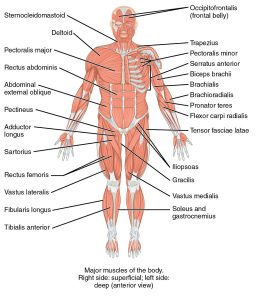
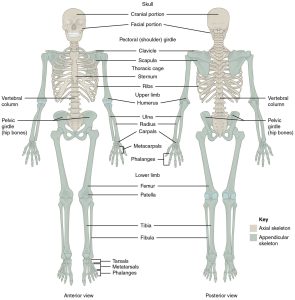
Functions of the Musculoskeletal System
Support, Movement, and Protection
The most apparent functions of the skeletal system are the gross functions—those visible by observation. Simply by looking at a person, you can see how the bones support and protect the body and facilitate movement. Just as the steel beams of a building provide a scaffold to support its weight, the bones and cartilage of your skeletal system compose the scaffold that supports your body. Without the skeletal system, you would be a limp mass of organs, muscle, and skin.
Bones also facilitate movement by serving as points of attachment for your muscles. Although some bones only serve as a support for the muscles, others also transmit the forces produced when your muscles contract. From a mechanical point of view, bones act as levers and joints serve as fulcrums (Fig. 4.3). Unless a muscle spans a joint and contracts, a bone will not move.
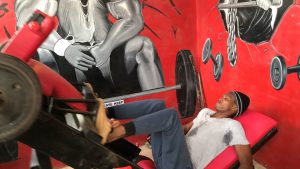
Bones also protect internal organs from injury by covering or surrounding them. For example, your ribs protect your lungs and heart, the bones of your vertebral column (spine) protect your spinal cord, and the bones of your cranium (skull) protect your brain (Fig. 4.4).
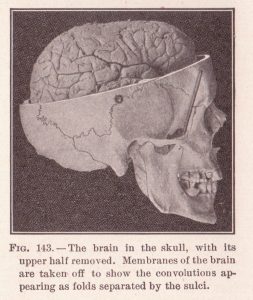
Key Concept
An orthopedist is a doctor who specializes in diagnosing and treating disorders and injuries related to the musculoskeletal system. Some orthopedic problems can be treated with medications, exercises, braces, and other devices, but others may be best treated with surgery.
While the origin of the word orthopedics (orth/o = “straight”; ped/o = “child”), literally means “straightening of the child,” orthopedists can have patients who range from pediatric to geriatric. Orthopedists commonly treat bone and joint injuries, but they also treat other bone conditions, including curvature of the spine.
Mineral Storage, Energy Storage, and Hematopoiesis
On a metabolic level, bone tissue performs several critical functions. For one, bone acts as a reservoir for a number of minerals important to the functioning of the body, especially calcium and phosphorus. These minerals, incorporated into bone tissue, can be released back into the bloodstream to maintain the levels needed to support physiological processes. Calcium ions, for example, are essential for muscle contractions and controlling the flow of other ions involved in the transmission of nerve impulses.
Bone also serves as a site for fat storage and blood cell production. The softer connective tissue that fills the interior of most bone is referred to as bone marrow (Fig. 4.5). There are two types of bone marrow—yellow marrow and red marrow. Yellow marrow contains adipose tissue; the triglycerides stored in the adipocytes of the tissue can serve as a source of energy. Red marrow is where hematopoiesis takes place. Red blood cells, white blood cells, and platelets are all produced in the red marrow.
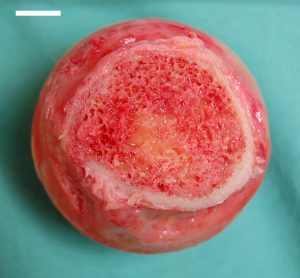
Muscles, Tendons, and Ligaments
The other parts of this system also provide integral functions within the human body. Think about the things you do each day—talking, walking, sitting, standing, and running. All of these activities require the movement of particular skeletal muscles. Skeletal muscles are even used during sleep. The diaphragm, for example, is a sheet of skeletal muscle that has to contract and relax for you to breathe day and night.
The ability to move the skeleton is complex and requires the tension created by the contraction of the fibres in the skeletal muscles to be transferred to the tendons. Tendons are strong bands of dense, regular connective tissue that connect muscles to bones. The bone connection is why this muscle tissue is called “skeletal muscle.” There are a number of different components within this system that work together in order for the skeleton to move and to perform other important functions within the body, such as the diaphragm noted above.
The following video provides an overview of the musculoskeletal system and some of the pathologies that can occur in this system.
(Alila Medical Media, 2020)
Attribution
Unless otherwise indicated, material on this page has been adapted from the following resource:
Betts, J. G., Young, K. A., Wise, J. A., Johnson, E., Poe, B., Kruse, D. H., Korol, O., Johnson, J. E., Womble, M., & DeSaix, P. (2013). Anatomy and physiology. OpenStax. https://openstax.org/details/books/anatomy-and-physiology, licensed under CC BY 4.0
References
Alila Medical Media. (2020, May 20). Overview of the musculoskeletal system, animation. [Video]. YouTube. https://www.youtube.com/watch?v=gSW2ryFmihk
Image Credits (images are listed in order of appearance)
Axial Skeleton-01-2014×2048 by LadyofHats, Public domain
1105 Anterior and Posterior Views of Muscles by OpenStax College, CC BY 4.0
Leg Press 2 by SAgbley, CC BY-SA 4.0
Page 215 Skull and Brain by Sue Clark, Public domain
Caput femoris cortex medulla by Stevenfruitsmaak, Public domain
the production of blood cells

